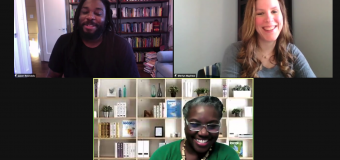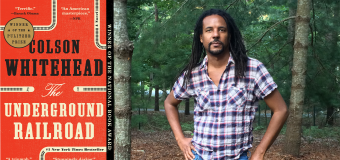More than 50 participants turned out virtually for “Reading Jason Reynolds,” a professor-led Zoom discussion of the issues and themes in the books of the bestselling author of works of young-adult fiction and, most recently, “Stamped: Racism, Antiracism and You.”
Two faculty from our College of Liberal Arts and Sciences, Tatiana Cruz (history) and Mary Dockray-Miller (English), as well as Graduate School of Education Language and Literacy Professor Mary Ann Cappiello, tackled Reynolds’s writing from their separate disciplines and vantage points.
The Thursday afternoon discussion was a precursor to Reynolds’s Feb. 23 talk, “The R-Word: How Racism Spread Across the Nation” or, as Dockray-Miller characterized it, “our warmup for our big event,” as with the “Underground Railroad” author Colson Whitehead lecture from October 2018.
Traditional treatment, untraditional subject
Dockray-Miller, the event’s de facto emcee, focused her 10 minutes on “As Brave As You,” of which she intoned, “If you’re only going to read one Jason Reynolds novel, this is the one to read.”
She pored over the coming-of-age novel, contrasting it with the traditional Bildungsroman, as the protagonist’s transition isn’t to adulthood, but from child to older child, examining the character of a glaucoma-suffering grandfather, a championing older brother and mysterious family conflict.
“He really articulates the general incomprehension that children feel as they (become) teenagers,” Dockray-Miller said. “I think it can speak to people of any age.”
And, as in other of Reynolds’s works, Dockray-Miller highlighted the role of guns in the narrative.
“I hope I’ve whetted your appetite to think of Jason Reynolds in a traditional literary way,” she said, even if he’s an untraditional young-adult author, one who, as he has said, writes books for people like him — kids that hated reading.
Multiple approaches
Cappiello, co-author with Dr. Erika Thulin Dawes of the forthcoming "Text Sets in Action: Pathways through Content Area Literacy," explored the various approaches teachers could take when navigating Reynolds’s books in their classrooms. She focused on the tale in verse “Long Way Down,” described by Reynolds as “’Boyz N the Hood’ meets ‘A Christmas Carol.’”
Leading participants through her slide presentation, Cappiello discussed the accessible, lyrical narrative of the young protagonist, Will, encountering six different victims of gun violence during a long ride in an elevator.
“It’s an incredibly powerful book and an important work,” she said. “It was important for him to write it in verse, so there would be no reason for children not to read this book.”
She explained that teachers could focus on the art form, the word economy inherent in verse, as well as its use of white space, making the text itself less dense and intimidating to reluctant readers.
If you have a child with a fear of dogs, she said, citing Reynolds, “The best way to get over it isn’t to take them to see ‘Cujo’ … but to take them to doggie daycare.”
Or teachers could focus the content, namely the disproportionate toll gun violence exacts on Black youth, or even choose to deconstruct the content, as the protagonist’s name, Will, is also a noun and a verb, while it also is shared by Shakespeare.
“Long Way Down” makes serious and sober themes accessible to young readers. That is also the intent of “Stamped: Racism, Antiracism and You,” an adaptation of Dr. Ibram X. Kendi’s award-winning “Stamped from the Beginning.”
‘Not a history book’
Dr. Cruz similarly used a slide presentation to lead participants through this latter work, to which she took exception in many places, though her criticism was focused on Kendi’s source material, rather than Reynolds’s writing.
Coincidentally, Cruz’s own son was assigned the work in this seventh-grade history class. Cruz understands, though ultimately objects to, “Stamped” insisting it is “not a history book” because “history books are boring” and its self-perception as “just an appetizer.”
History, in contrast, is far more nuanced and substantial than the Kendi/Reynolds book, Cruz indicated, and the writing suffers from flat, simplistic characterizations of individuals slotted into three categories: Segregationists (haters), Assimilationists (they “like” you) and Antiracists (they like you because they’re like you).
Cruz said the book tracks racism from the 1400s, using a “cool, authentic” author’s voice replete with rap and pop culture references, though she wonders how the work will age.
“Are young people going to say he’s corny” in the future? Cruz mused. However, she, like Cappiello, praised Reynolds’s use of white space in the text, which prompts readers to pause and contemplate difficult matters and big ideas.
And, she said, “He effectively teases out dominant narratives. … He presents white abolitionists as the OG antiracists.”
While thinking of Sen. Charles Sumner and others as Original Gangstas might seem odd, they do provide an early example of white allyship, Cruz noted.
Yet, Cruz added, “He doesn’t talk about whiteness, how whiteness was invented and how English colonists used it to differentiate themselves from other people.”
In Cruz’s post-presentation “breakout room,” she clarified that she enjoys Reynolds’s work and is looking forward to hearing his Feb. 23 lecture, especially since — largely, though not entirely, due to the pandemic — many faculty of color haven’t yet had the opportunity to meet their celebrated colleague.
But they and others can meet Reynolds virtually, both at his Feb. 23 lecture and via the pages of his award-winning oeuvre.



